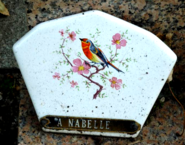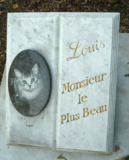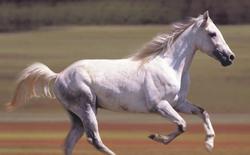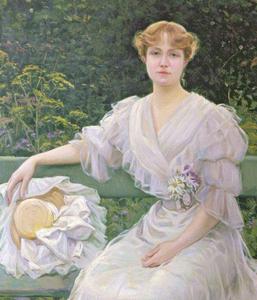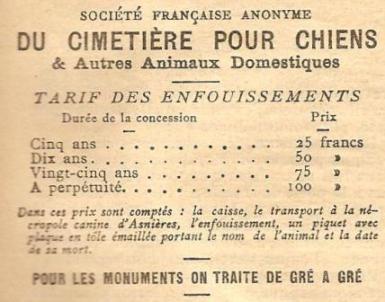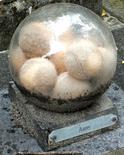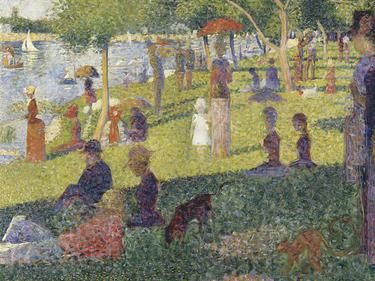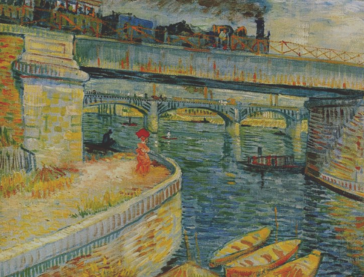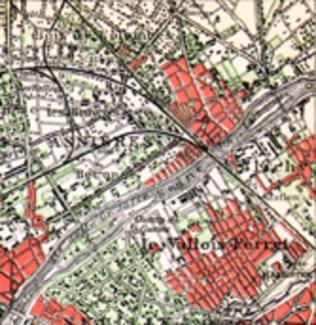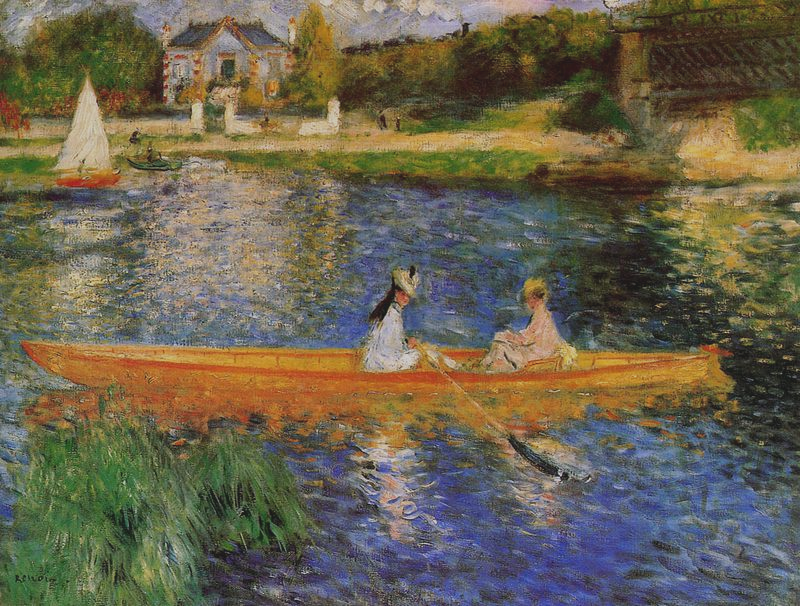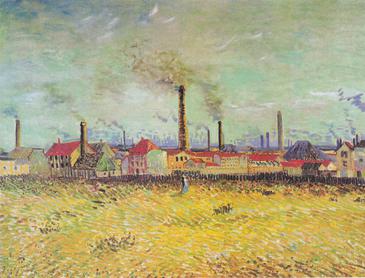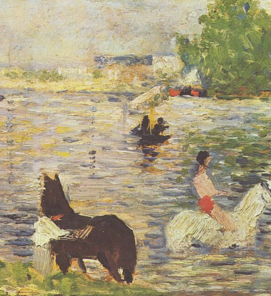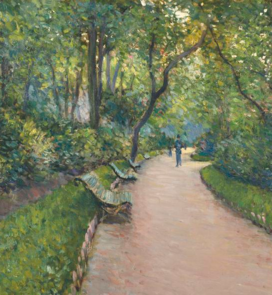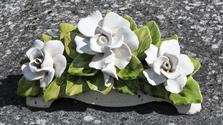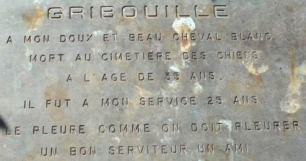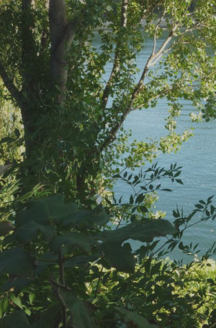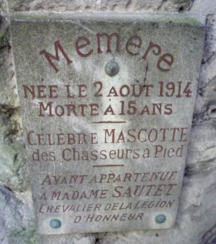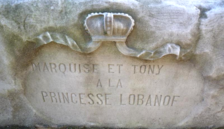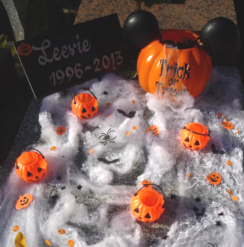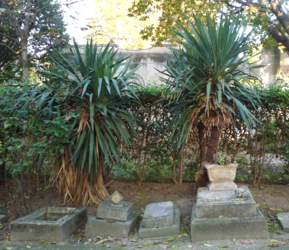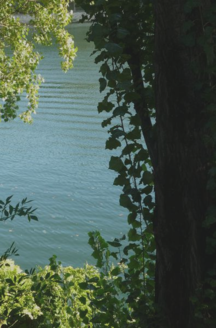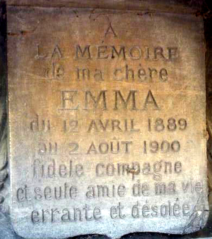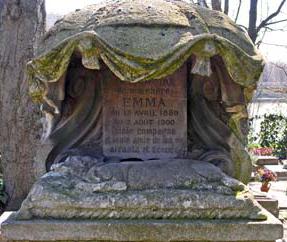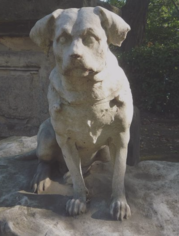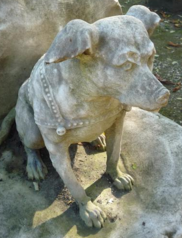Women's Travel Abroad
For Women About Women By Women
Cemetery of Dogs and Other Domestic Animals
Asnieres-sur-Seine
Of all the cemeteries in Paris I found this one the most difficult to locate. Like human graveyards of Paris, licensed after the dismantling of the urban cemeteries, it is situated outside of the city limits. The first time I walked from the Line 13 Gabriel Peri metro station along the Quai Dr. Deraux, past Parc Robinson, until I saw a sign pointed toward the Seine. I turned right, crossed the street, and finally arrived at the front gate of the cemetery.
The walk had taken longer than I expected and the grand facade was all I got to see. Arriving at the cemetery I still had an hour left to explore before the scheduled closing time but the caretaker decided to close up early because of bad weather. I was really disappointed about the early closing. Resting on a park bench in front of the cemetery I met two local French women. In English they said they were also disappointed saying "it is so French".
However, this trip was not a complete bust. One of the women, who was preparing a walk for Paris tourists, recommended I see the stamp show at the Chateau d'Asnieres. She also told me the area around the dog cemetery was a popular rural spot for urban Parisians to visit in the late 1800's and mentioned that several well known impressionist artists had spent time partying at the Chateau with their friends and painting on the banks of the Seine.
GRIBOUILLE
Mon Doux et Beau Cheval Blanc
Mort Au Cimitiere Des Chiens
A L Age 35 Ans
Il Faut A Mon Service 26 Ans
Je le Pleure Comme On Doit Pleurer
Un Bon Serviteur Un Amie
Marguerite Durand
1899
GRIBOUILLE
My Sweet and Beautiful White Horse
Died At The Cemetery of Dogs
At The Age 35 Years
After Being In My Service 26 Years
I Weep As One May Cry
A Good Servant A Friend
Marguerite Durand
1899
L'ile des Ravageurs
ASNIERES-SUR-SEINE
1800's
Chateau
Clichy Bridge
Among the famous painters were Renoir, Seurat, and Van Gogh who had painted scenes of Asnieres. Auguste Renoir's painting of, The Skiff (1879), shows two young women rowing a boat in the rippling water of the river with a small sailboat in the background. Georges Seurat painting, A Sunday on Le Grande Jette (1884), portrays groups of numerous people enjoying a Sunday out on the banks of the river. In the background you see a skiff but the sailboat is much larger than the one in Renoir's The Skiff.
Vincent Van Gogh painted an entirely different view of the city. His paintings show us a more industrialized image of Asnieres. Looking at the map you can see agricultural plots of land on the outskirts of Asnieres but in Van Gogh's paintings, Bridges Across the Seine at Asnieres (1887) and Factories at Asnieres, Seen From the Quai de Clichy (1887), we see the expansion of railroad transportation and manufacturing facilities in the once charming, bucolic rural retreat of Asnieres-sur-Seine.
On my second attempt to visit the Cemetery of Dogs I decide to disembark on the metro Line 13 Marie de Clichy stop. It appears to be about the same distance from the cemetery as the Gabriel Peri stop but there are fewer twists and turns in the route. Exiting the Marie de Clichy stop I simply follow the metro line along Avenue de Clichy. Like the railroad in Van Gogh's painting the metro also goes over the Clichy bridge.
I hear the noisy metro above me and see the automobiles speeding by me as I walk safely along the pedestrian pathway. Looking out from the bridge I have a lovely view of the river. When I reach the end of the bridge I see a sign on my left pointing to the cemetery and park. The traffic is heavy so I wait until it clears and bolt across the street. Making a quick left turn I enter the Place Marguerite Durand. There are vendors outside the front gate selling flowers.
The Grand entrance is not open. Instead I enter through a small gate to my right. No one is at the window of the guardhouse. I knock on the door. After a few minutes the guard peeps out. I hand him my admission fee and ask for a map. He tells me today there is no fee but no map either. I ask if there are restroom facilities in the cemetery. He waves me off, telling me they are in the park. Unfortunately, I find no restrooms in the park so I return to the cemetery.
Marguerite-Charlotte Durand was born in Paris on January 24th, 1864. She was the daughter of Anna-Alexandrene Durand, a well educated, published writer. Her father may have been General Alfred Boucher, a royalist and grand officer of the Legion of Honor, or the sculptor, Auguste Clesinger. She lived her entire life in Paris attending the Dames Tritinian convent school as a youth and the Conservatory of Dramatic Art in her teens. She began acting at the Comedie Francaise when she 17 years old.
order at paintingandframing.com
Durand had a successful career playing comic and tragic roles in plays of famous French writers - Moliere and Dumas fils. Working at the Commedie Francaise she made friends with the actresses Sarah Bernhardt and Severine. In 1886, after only 5 years on the stage, she left the theater to marry an aspiring revolutionary, socialist politician and lawyer, Georges Laguerre. During the five years they were married she assisted her husband helping manage his career and run his radical newspaper, le Presse.
After her divorce in 1891 she, like her mother, began a career as a free-lance journalist. During her time writing for Le Figero she was sent to cover the 1896 International Feminist Congress in Paris. It is generally believed this writing assignment was a turning point in her life. For the first time she became face-to-face with many other women who were struggling with issues of gender transparency and oppression.
The humorous story Marguerite was assigned to write by her editor at Le Figero led to a very serious writing assignment of her own. A year later she left Le Figero to start La Fronde, a journal with the same mandate as this website - for women, about women, by women. This was a major gender shift from a newspaper that made fun of women to a publication that took women seriously.
Beginning in 1897 La Fronde was published daily. From 1903 to 1906 it was published monthly. The feminist journal focused on reporting news and writing articles exclusively of interest to women. It had a nationwide circulation of 200,000 readers. She offered female teachers a discounted subscription fee.
Her entire staff was female. Marguerite managed the newspaper herself. She employed only women and paid them the same wages as men doing the equivalent jobs of writing, selling, and typesetting a publication. She also provided them with an attractive and safe workplace, generous personal benefits, and supported their plan to form a typesetters union for women.
It is not clear how Durand found out the island was for sale. Perhaps Gribouille was stabled in the fields surrounding Anieres-sur-Seine and bathed in the Seine like in the painting of Bathers at Asnieres (1883) by Georges Seurat. Maybe Marguerite spent time here relaxing here with her friends and saw a FOR SALE sign posted on the island.
Purchasing the island for the cemetery provided Marguerite and other pet owners with a place to inter their beloved pets. Her horse, Gribouille, was the first animal to be buried in the cemetery. On his tombstone Marguerite had engraved a touching tribute to him. She tells us Gribouille had been her sweet, beautiful, servant, and friend for twenty six years. Marguerite weeps at his death.
Gribouille's tombstone is located in front of the monument to Barry, the heroic Saint Bernard. Her pet lioness Le Tigre, who she often exercised on the gravel pathway of Park Monceau painted by Gustave Caillebotte, does not seem to be buried here. I looked but could not find his grave.
Interring a pet in this public cemetery was not free. Payments on the land had to be made, a yearly city tax paid, and a salaried grounds keeper employed. In 1902 it cost 5 francs to bury an animal in a common grave. A private plot cost 25 francs for 5 years, 50 francs for 10 years, and 75 francs for 25 years of uninterrupted burial. An undisturbed grave cost 100 francs. Current rates are 700 euros for 10 years, 2,500 euros for 30 years, and 13,000 euros for 99 years. Today, interment costs another 70 euros and a monument 1,000 euros or more depending on their design.
In the early years of the pet cemetery the Society Francais Anonyme also established regulations and rules for animal burials. Graveside services were prohibited. Wooden caskets and urns, specially sized for animal remains, were picked up from homes and wheeled to the cemetery in a small, hearse-like vehicle. The grounds keepers deposited the casket or urn in the grave and installed the marker.
By the late 1950's over 40,000 animals (birds, hamsters, mice, rabbits, squirrels, turtles, dogs, cats, monkeys, horses, and even a sheep and shark) were buried here. To date about 100,000 animals have been buried in this cemetery over the last hundred years.
One of the largest monuments, located near the entrance and behind Gribouille's tombstome, was built in 1906 as a tribute to Barry. Barry, the Saint Bernard, saved the lives of forty-one people trapped in a Swiss snow slide. Oddly, the dog is not buried in the cemetery. When he died Barry was stuffed by a taxidermist. He is on display at the Natural History Museum in Bern, Switzerland.
Initially restrictions were placed on the types of markers allowed on graves. The markers varied in stature and style depending on the social status and finances of the pet owner. Most of the tombstones, from simple to ornate, are almost exact copies of those found in human cemeteries. However, over time the rules were reevaluated and relaxed. Today, as I look around the cemetery I see a jumble of unpretentious slab stone markers situated right next to grandiose monuments.
The cemetery map shows two famous dogs of the stage and screen are also buried here: a French dog, the Prince of Wales, who performed on the stage at the Theater du Gymnase from 1905 to 1906 and the French born American film star Rin Tin Tin. However, Susan Orleans (Rin Tin Tin: The Life and Legend, Simon and Schuster, New York, 2011) questions if Rinty is actually interred here.
The cemetery has no record of Rin Tin Tin's burial. Rin Tin Tin's owner, Lee Duncan, was homeless and broke when his canine star died. Duncan moved in with his sister Marjorie and buried Rinty in her back yard. Orlean thinks a devoted fan may have bought the cemetery plot and placed the marker on it as a memorial to Rin Tin Tin.
In 1986 the administrative council of the Society Francaise Anonyme wanted to close the cemetery because of financial difficulties. Responding to a public outcry from pet owners who had graves in the cemetery and concerned citizens who spoke for the animals buried in graves whose owners had passed on, the mayor's office submitted a plan to the French government. They maintained the site was of historic and cultural importance.
I suspect the debate to save the cemetery was highly emotional. I can imagine the French heatedly arguing the pros and cons, from both human and animal points of view, of maintaining the site. People with pet graves in the cemetery were probably angry because they had already paid the burial fees and would have to pay an additional 70 euros to disinter their pet without knowing where the remains would end up.
Originally the cemetery was divided into four sections which separated the burials of dogs, cats, birds, and other animals from each other. As I walk the first part of the cemetery I see mostly graves to dogs. The size of the tombstones vary in size and style. I find the graves of privately owned dogs marked by simple slab markers encased with a metal fence and upright tombstones set in a marble bed alongside complicated carved monuments.
The design of grave markers changed with the fashion of the times. Sculptures of dogs and cats appear to be a popular decoration no matter what the era. Inscriptions are fairly short and sweet stating the name of the animal, date of birth and death, and a brief tribute. Early descriptive tributes are generally a statement about the person-pet relationship and were often chosen from a list of those provided by the monument designer or tombstone engraver.
As I walk along the path I come upon graves dedicated to all sorts of animals. I find tombstones and monuments to dogs, cats, birds, and even a monkey mixed together in a somewhat unpredictable pattern. I also begin to see much older weather-beaten graves situated right next to newer burials. It appears that over the years, as the number of animal burials increased the lines of demarcation between species became ever more blurred.
The cemetery has been embellished and updated during the last century. The grand Art Nouveau front entry gate was added in the 1920's. Decorative fountains and sculptures were constructed. Gardens were planted and there are wooden benches that give the cemetery a park-like feeling. I am touched to see a man seated on the bench obviously mourning the loss of his pet.
I humorously imagine angry American fans of Rin Tin Tin wondering if his grave would be desecrated and the remains their canine hero ending up who knows where. As the two Parisian women I met on my first visit said to me this kind of behavior is "so French".
Mon deux, I think, the French people were probably saying the the same thing. They accused the society of wanting to sell the land for development. Citizens may have been asking each other if millions of euros was worth desecrating graves of their heroes and beloved pets.
I envision them, with great decorum and pinache, brandishing a baggette in one hand and a glass of red wine in the other shouting "NON! NON! We cannot allow this to happen! We will fight! We will save the cemetery... for the animals and for the people of France!" And save it they did! The Cemetery of Dogs and Other Domestic Animals is now a historical site of national importance managed by the city of Asnieres-sur-Seine. Thanks to their valiant commitment and the dedicated members of the mayor's council the cemetery is still open so I can be among one of the 3,500 other people who visit yearly.
Strolling along the paths I notice more people in the modern part of the cemetery cleaning and decorating the graves of their pets. They scrub and polish the grave stones and replace withered and wilted flowers. I see them bend their heads as if reciting a little prayer and visiting with each other probably sharing memories of their wonderful pet. I try not to interrupt their activities as I take photographs.
Sitting down on a bench I put my camera away. Looking around I see a family tenderly caring for the grave of their deceased pet. It makes me feel happy to know the people of Paris have a special place where they can put their pets to rest. Watching them gives me the feeling this cemetery is a safe place for them to share their grief and loss with each other.
I recall how sad I was when my dog Orion died. I was pregnant and had wanted my child to know Orion. Visiting the prenatal clinic I told the doctor about the loss of my dog. He assured me the birth of the baby would make me forget the death of my dog. I buried my dog Orion in my yard and put a stone on his grave. Three days later my baby was born. Of course, I was elated to have a son but I still grieve for my dog.
Wiping away a sentimental tear I proceed on my way. It is almost time for the cemetery to close and I need to get moving. Walking back toward the entrance I find many grave sites adorned with pots, wreaths, or nosegays of fresh flowers. I chuckle at Leerie's grave festively tricked out with plastic pumpkins, spiders, and spider webs. Other grave sites have been decorated with glass beads, shells, statuettes, and flowers.
Someone is blowing a whistle. I assume it is the guard letting us know the cemetery is closing. Trekking back to the front gate I pass an astonishing monument I had not noticed before. A young woman is carefully arranging bouquets of flowers, an ebony engraved placard, and plush little stuffy toy on a huge, black marble monument. This modern marker has the works - a photo of her dog, marble vase and placard, and gold engraving. WOW!
Even more amazing is the dog owner's complete lack of self-consciousness. She often moves the decorations around from one place to another taking lots of photos of their new positions while listening to doleful music on her cell phone. I am certain her dog, Caramel, who was born on February 2, 1996 and died on December 7, 2013, must have spent the entire seventeen years of her life being pampered and loved. The epitaph she has written to Caramel certainly tells me how much her 'daughter' meant to her.
I simply cannot resist talking to her. I find her name is Patricia. I ask her about Caramel. We talk a little about our deceased doggies. Even though our conversation is stilted, because of we both lack fluency in each others language, I feel we are sharing a special moment talking about one the important relationships in our lives ...the love we have for our pets and the sadness we feel over the loss of our animal friends.
She kindly allows me to take a photo of her at Caramel's grave site. As I walk away from her I feel a gentle tap on my shoulder. When I turn around she asks me if I will take a photo for her. Of course, how can I resist such an endearing request. I take a photo of Patricia at her beloved Caramel's memorial catching an image of this poignant, melancholy moment for all time.
CARAMEL
02.02.1996 12.07.2013
Ma fille
L'amour de ma vie
J t'aime
Ta maman
CARAMEL
02.02.1996 12.07.2013
My daughter
The love of my life
I love you
Your mama
Please Feel Free to Contact Me Personally With Comments or Questions
Copyright 2017 Creative Travel Publications, LLC - Minneapolis, MN
It is All Saints Day. The city feels deserted. Many stores along the Avenue Marie de Clichy are closed for the holiday and I see very few shoppers out and about. However, I suspect there are many people at the city cemeteries visiting and decorating the graves of deceased family members or friends on this religious holiday. I wonder if there will also be a lot of people at the Cemetery of Dogs laying flowers on their pets in the same way they do for human loved ones.
Approaching the exit of the cemetery I take one last look around. For me the time I spent here has been enlightening. In just a few hours and acres I have experienced an entirely new dimension of Parisian life. I have learned about the genuine respect and love they feel for their animal companions. I think about the past and how until the opening of this cemetery the Parisian people had no proper way to honor that relationship. It seems the 40,000 pets now buried here will be remembered in posterity with dignity and reverence thanks to Marguerite Durand, her fellow animal lovers, and the city of Asniere-sur-Seine.
Leaving the cemetery I decide to see if I can locate the restrooms in Parc Robinson. Walking past the back of the pet cemetery, a children's playground, and adult exercise equipment I come upon several colorful signs advertising Cirque Europa but none directing me to restrooms. The Cirque Europa signs feature beautiful show girls, colorfully painted clowns, and lots of exotic and ordinary animal performers: elephants, camels, tigers, lions, and horses.
It seems ironic to me the circus is set up here, on All Saints Day, in the same locale as the pet cemetery. The circus animals make me once again think about our human relationships with animals. Historically they have serviced us in so many ways and continue to do so. It is likely Marguerite Durand used Gribouille to transport her around the city. It is said she paraded Le Tigre on the sidewalks of Paris to promote her political campaign.
Protective animals, like heroic Barry the Saint Bernard and police dogs, who have forfeited their lives to rescue people and keep us safe deserve monuments erected in their honor. Our companion animals make life happy and their deaths cause us great sorrow. Even the death of animals who have provided us with hours of unabashed entertainment, like the French theater dog Prince of Wales and the American cinema dog star Rin Tin Tin, may make us sad.
I proceed down the gravel path walking close to the banks of the Seine. A man on a noisy jet ski is making waves on the river while men in quiet repose fish from a dock. Finding no restrooms I leave the park going to the Gabriel Peri metro stop instead of heading back through the park, over the bridge, and down the avenue to the Marie de Clichy metro stop.
If you plan on visiting the cemetery you will find information (in French) about opening hours and prices, a brief history of the site, and a map of important graves on www.asnieres-sur-seine.fr. You can use Google translate for printable English version.
The cemetery may be closed anytime at the discretion of the caretaker. It is open to the general public and animals on a leash. You are asked not to feed the resident feral cats. A charitable group of citizens tends them daily. There is a small admission fee except on All Saints Day. Allow plenty of time to get to the cemetery. Be sure to use the Line 13 metro line and get off at the Marie de Clichy metro stop. It is the most direct and well signed route to the cemetery.
Destinations
wikiart.com
wikiart.com
wikiart.com
wikiart.com
wikiart.com
wikiart.com
The Cemetery of Dogs and Other Domestic Animals is the oldest pet graveyard in Europe. It was opened in 1899 shortly after the passing of a legislative bill that allowed pet owners to bury their deceased animal companions in a location that met certain sanitary requirements. Up until then small pets were thrown in the trash or the river or sold to doctors for dissection, both of which were unhealthy and inhumane practices.
Horses, on the other hand, were taken to the glue works or skinned for their hides.
Establishing a cemetery was the idea of three Parisians: the author Emile Zola, a lawyer Georges Harmois, and the journalist Marguerite Durand. Along with a group of anonymous donors they purchased a small island in the Seine, the L'ile des Ravageurs, which gave pet owners a hygenic place to inter their faithful animal companions. Previously, the island had been used by "rag and bone men" of Paris to store heaps of junk and scrap. Ravageurs resided on the island earning their living by wading out into the river, mining the silt, and selling the precious metal and stones they found in the muck .
It seems Marguerite began to apply her activist personality to another plan when she bought the land for the Cemetery of Dogs. Durand was an ardent anti-vivisectionist. She deplored the inhuman treatment animals experienced at the hands of the surgeons and scientists who used the animals for teaching and research. She also had an intense personal attachment to a particular animal - Gribouille, her beloved white horse.
Gribouille was undoubtedly a very important "friend" for Marguerite. She had been Marguerite's companion since childhood serving her well into adulthood. By the time the city of Paris had passed the law in 1898 Gribouille would most likely have been infirmed and quite possibly incapacitated. Durand certainly knew the gruesome lot of dead horses. Too big to be put in the trash or dumped in the river they ended up being carted off to the knackers.
Grand monuments and simple tombstones are scattered randomly throughout the cemetery. Most mark the graves of pets that belonged to ordinary people like me. The heart felt epitaph, written to by Emma's mistress, tells me her dog Emma was a faithful companion and only friend during the bad times. This monument, erected in 1900, is one of the oldest markers in the cemetery.
There is also a monument to police dogs (Chiens Policiers Sauvettes) which attests to the important role canines played in protecting people from harm. Moustache, the mascot of Napoleon's Grand Army, who was killed in the Spanish Campaign of 1811, is buried here. Another famous canine mascot of the French Light Infantry, Memere, is interred in the cemetery.
Many royals have buried their pets here. The Comte and Comtesse Alexander Dumas interred their dog, Sulley, in this cemetery. Drac, the beloved dog of Princess Elisabeth of Romania is interred here. Princess Lobanof built a grand memorial to her dogs Marquise and Tony.

